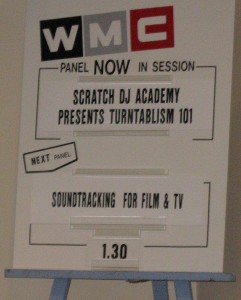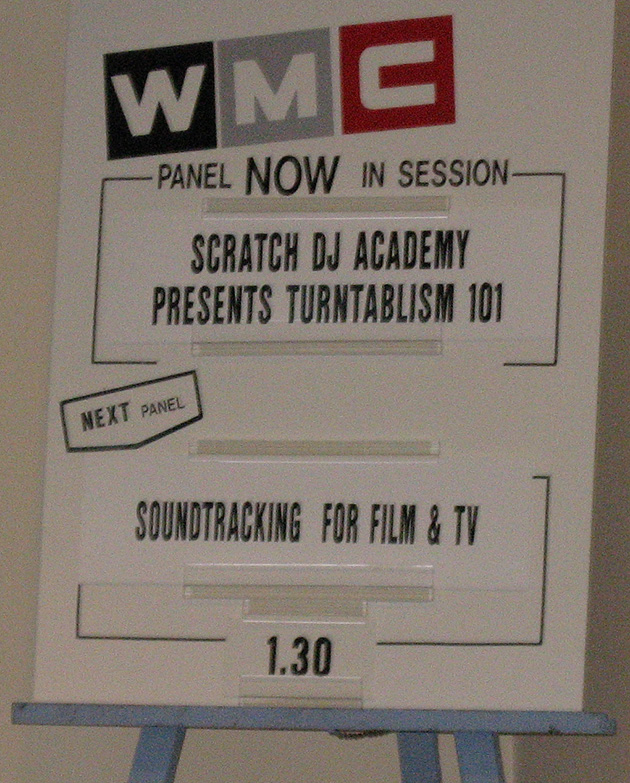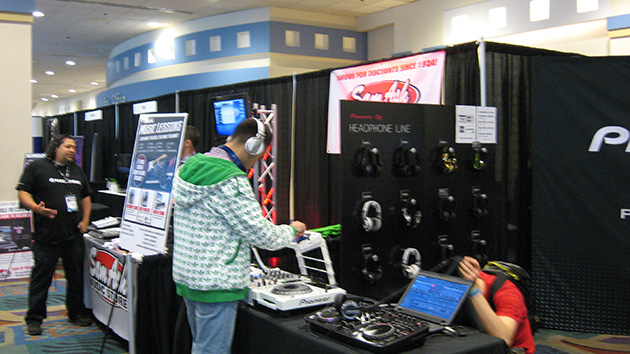 Although the state of the industry is the focus of the Winter Music Conference, gear plays a sizeable part, with brands showcasing their products at a two-day exhibit and doing demonstrations. Along with checking out the exhibits, we stopped by the Gibson Pro Audio (Stanton and KRK) and Pioneer demonstrations on March 18 and 19, respectively.
Although the state of the industry is the focus of the Winter Music Conference, gear plays a sizeable part, with brands showcasing their products at a two-day exhibit and doing demonstrations. Along with checking out the exhibits, we stopped by the Gibson Pro Audio (Stanton and KRK) and Pioneer demonstrations on March 18 and 19, respectively.
Exhibits
Considering the size of WMC, the exhibit section was underwhelming for any gear head. U.K. companies Prism Sound and MASELEC had their digital and analog studio equipment on display, with Prism passing out information about its Sound Lyra USB interfaces, which are designed for small format audio sound cards. The new gear features four, six, and 12 input and 16 output configurations.
Pioneer, meanwhile, had a few tables filled with the DDJ-ERGO Limited Controller, the CDJ-850, XDJ-AERO wireless DJ system, the DDJ-SX, and DJM-900 mixer with the CDJ-2000.
Stanton – Gear Demo
Also called “Sound Off!” after the Caribbean culture sound battles, the Stanton – or, properly, Gibson Pro Audio – gear demo featured recent Cerwin-Vega, KRK, and Stanton DJing and audio products, with DJ/producers and Gibson employees B-Side and Carlito Sway demonstrating. The panel, before starting, informed the audience that Gibson, known primarily for guitars, purchased all three a year ago, with the goal of keeping ahead with the next musical revolution.
KRK RoKit monitors were first displayed, with B-Side explaining the distinct yellow cone makes the brand popular. No matter the product tier (RoKit for a professional sound in your home studio and VXT for major studios), all are built to produce a clean, even, natural sound without distortion for monitoring mixes.
A few sound demos used the 10-3, which we already reviewed in 2012 and Gibson considers a midfield monitor. B-Side and Sway explained the 10-3 has enough power to fill a room and still has a balanced wave of sound even farther back.
Low- and high-frequencies soon became the focus after the demonstrators explained the 10-3 has these adjusts in the back, which allows this, along with the three separate inputs, KRK monitor to operate in any studio environment. Compared to the Yahama HS series, KRK RoKit 10-3 monitors have a more balanced, accurate, “more natural” sound, they explained.
Gibson’s team then moved onto the Cerwin-Vega P Series, which includes full-range PA speakers. What’s particularly unusual about the models is the concentric driver, which is ideal for producing smooth vocals and higher frequencies, and both demonstrated are top, or high frequency, speakers. Cerwin-Vega, for those who don’t know, is known mostly for its bass-range products.
The P1500X, one of the featured speakers, also has an innovative design: a stretched-out oval, instead of a circle, for wider dispersion; rather than be even around, the speaker is 90-degrees wide and about 65-degrees up and down. According to B-Side the P1500X produces a “smooth, louder vocal range that doesn’t tear your ear off.”
After the Cerwin-Vega products, B-Side and Sway moved onto a Stanton MIDI controller: the SCS 3 Pack, which has all parts held together with magnets and allows the user to switch between two decks in a single unit. Internal mode, B-Side demonstrated, lets the DJ control the track with the platters rather than the time codes.
The Stanton SCS.4, which we also reviewed in 2012, “has everything you would need to actually DJ with,” B-Side claims: a full two-channel mixer and naturally-weighted zinc platters that “won’t ever jump out of place” and won’t wear out. All the DJ has to do, they showed, is add a thumb drive, as the SCS.4 already has a computer unit, along with a microphone, recording capabilities, and software.
Pioneer – Gear Demo
On day two, the switch from CDJs to controllers and laptops was a running theme throughout the panels, and Pioneer made it the entire focus of their presentation, “Entering the Controller Market & How to Choose the Right Controller for You.” With Pioneer product specialist DJ Jay Brannan presenting, along with other brand employees, a slide show outlined the positive aspects – and common misconceptions – of switching from one medium to the other.
Brannan admitted early on he was one of the many DJs that felt reluctant to make the switch, but he said, “I’m man enough to admit I was wrong, wrong, wrong.”
Brannan prefaced his presentation by telling the audience he’s a mobile DJ – someone, essentially, who does weddings, sweet 16s, and similar events. His points, then, skewed to the advantages controllers have in his field: better search-ability and organization, easier to transport than CDs and older gear, better for pre-preparing tracks, waveforms make mixing easier, recalling track history is simpler, and setup takes less time.
When members of the audience expressed concern at the small size of the controller, Brannan replied with: “That’s not the case anymore with controllers. People have to wake up.”
He later went onto finish this point, stating: “The technology makes the gear change, but the goal is always the same.”
Toward the end of the presentation, before Brannan ran down the list of Pioneer’s controllers and the common software options, one of the other Pioneer employees mentioned the company specifically designed their products for adaptability: “When we designed the controllers, we wanted an easy transition from controller to CDJ.”
Vinyl and CDs versus Laptops
If the Pioneer demo just touched the surface regarding the vinyl/CDJ versus laptop debate, the “Pushing Buttons: The Laptop vs. Traditional DJ” panel, which featured a total of eight DJs/producers and a moderator on stage, delved in far deeper. However, while it touched on several points we on this website have mentioned before, it didn’t actually get to a resolution.
A Rolling Stone article was the jumping point, but what the panel ended up touching on is:
1. There is no industry standard.
While Murk’s Oscar G, who began on vinyl but moved onto Traktor, stated, “I think one of the cool things is, there is no standard,” regarding gear, another DJ by the name of Lessio explained the wide range of options causes problems (and requires multiple backup solutions) for playing in a club.
2. Some miss vinyl and some don’t.
Markus Schulz explained he had to give up vinyl when touring became extensive, and in addition to using Serato with time-coded discs, he carries around a USB with a cloned backup. He later went onto say, “For me,
Others didn’t agree. When answering the same question, Tommie Sunshine said, “My biggest regret of switching [to digital] is, nothing is better than vinyl,” and goes onto describe the thin sound of the digital kick drums.
3. These days, production comes before and is DJing
The Disco Fries’ Daniel Boselovic pointed out the issue that, in today’s musical climate, a DJ must make a name for himself first (usually with an original production) to get booked. While the ease of accessing digital music takes away the high price tag of vinyl, not everyone can be a DJ, the panel pointed out – a new production essentially defines a modern career.
Sunshine then took the discussion in another direction, claiming that, during the days of vinyl, mashups and added vocals weren’t necessary; instead, the records were simply better.
Schulz then, on the topic of using prerecorded music, mentioned, “There’s no one type of DJ” and then went onto clarify the two types: the one who respects the art (usually a club resident who doesn’t rely on the synch button), and newer producers who make a hit record first, get booked for Ultra, and then are later criticized by the purists.
4. Why are we even having this discussion? DJing is about the audience
Toward the end, Oscar G told the panel, “The whole art is being held back by this dumb discussion. I think the art of DJing is what comes out of the speakers and the crowd’s reaction.” The rest of the speakers agreed, with others adding that their decisions for tracks are based on the audience rather than keeping vinyl alive or sticking with a more authentic-seeming medium.





